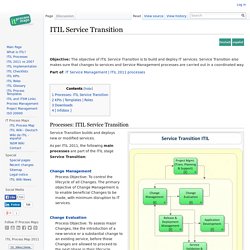

Best Management Practice for portfolio, programme, project risk and service management. ITIL V3 CSI - Continual Service Improvement. ITIL Continual Service Improvement (CSI): Overview. ITIL Processes. ITIL Processes according to ITIL 2011 The within IT Service Management ensure that IT Services are provided in a focused, client-friendly and cost-optimized manner. With their help, IT Services are clearly defined, success can be measured with regards to the service provision, and targeted improvement measures can be introduced where necessary.
In ITIL 2011 (ITIL V3 2011 Edition) the ITIL processes are grouped into five stages (see Fig. "ITIL Processes" ): . Process Objective: To decide on a strategy to serve customers. Process Objective: To design new IT services. Process Objective: To build and deploy IT services. Process Objective: To make sure that IT services are delivered effectively and efficiently. Process Objective: To use methods from quality management in order to learn from past successes and failures. ITIL V3 Service Strategy. ITIL Service Strategy The objective of is to decide on a strategy to serve customers. Starting from an assessment of customer needs and the market place, the Service Strategy process determines which services the IT organization is to offer and what capabilities need to be developed.
Its ultimate goal is to make the IT organization think and act in a strategic manner. ITIL V3 Service Operation. ITIL Service Operation The objective of is to make sure that IT services are delivered effectively and efficiently. This includes fulfilling user requests, resolving service failures, fixing problems, as well as carrying out routine operational tasks. : IT Service Management Processes: ITIL Service Operation ITIL Service Operation - Click on a process for more details As per , the following processes are part of the ITIL stage : Event Management Process Objective: To make sure CIs and services are constantly monitored, and to filter and categorize Events in order to decide on appropriate actions. Incident Management Process Objective: To manage the lifecycle of all Incidents. Request Fulfilment Process Objective: To fulfill Service Requests, which in most cases are minor (standard) Changes (e.g. requests to change a password) or requests for information.
Access Management Process Objective: To grant authorized users the right to use a service, while preventing access to non-authorized users. ITIL V3 Service Design. Objective: The objective of ITIL Service Design is to design new IT services.

The scope of Service Design includes the design of new services, as well as changes and improvements to existing ones. Part of: IT Service Management | ITIL 2011 processes Processes: ITIL Service Design ITIL Service Design - Click on a process for more details Service Design identifies service requirements and devises new service offerings as well as changes and improvements to existing ones. As per ITIL 2011, the following main processes are part of the ITIL stage Service Design: Design Coordination Process Objective: To coordinate all service design activities, processes and resources.
Service Catalogue Management Process Objective: To ensure that a Service Catalogue is produced and maintained, containing accurate information on all operational services and those being prepared to be run operationally. Service Level Management Risk Management Process Objective: To identify, assess and control risks. Downloads. ITIL V3 Service Transition. Objective: The objective of ITIL Service Transition is to build and deploy IT services.

Service Transition also makes sure that changes to services and Service Management processes are carried out in a coordinated way. Part of: IT Service Management | ITIL 2011 processes Processes: ITIL Service Transition Service Transition builds and deploys new or modified services. As per ITIL 2011, the following main processes are part of the ITIL stage Service Transition: Change Management Process Objective: To control the lifecycle of all Changes.
Change Evaluation Process Objective: To assess major Changes, like the introduction of a new service or a substantial change to an existing service, before those Changes are allowed to proceed to the next phase in their lifecycle. Project Management (Transition Planning and Support) Process Objective: To plan and coordinate the resources to deploy a major Release within the predicted cost, time and quality estimates. Application Development Knowledge Management.